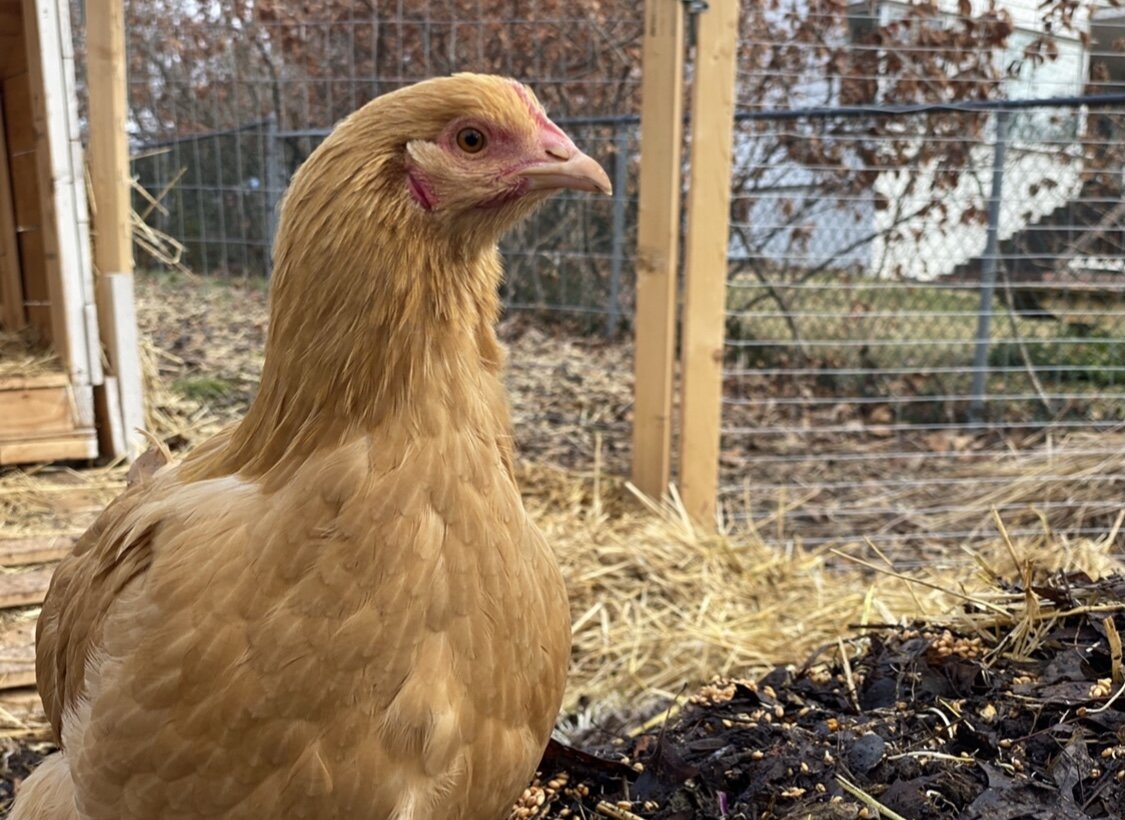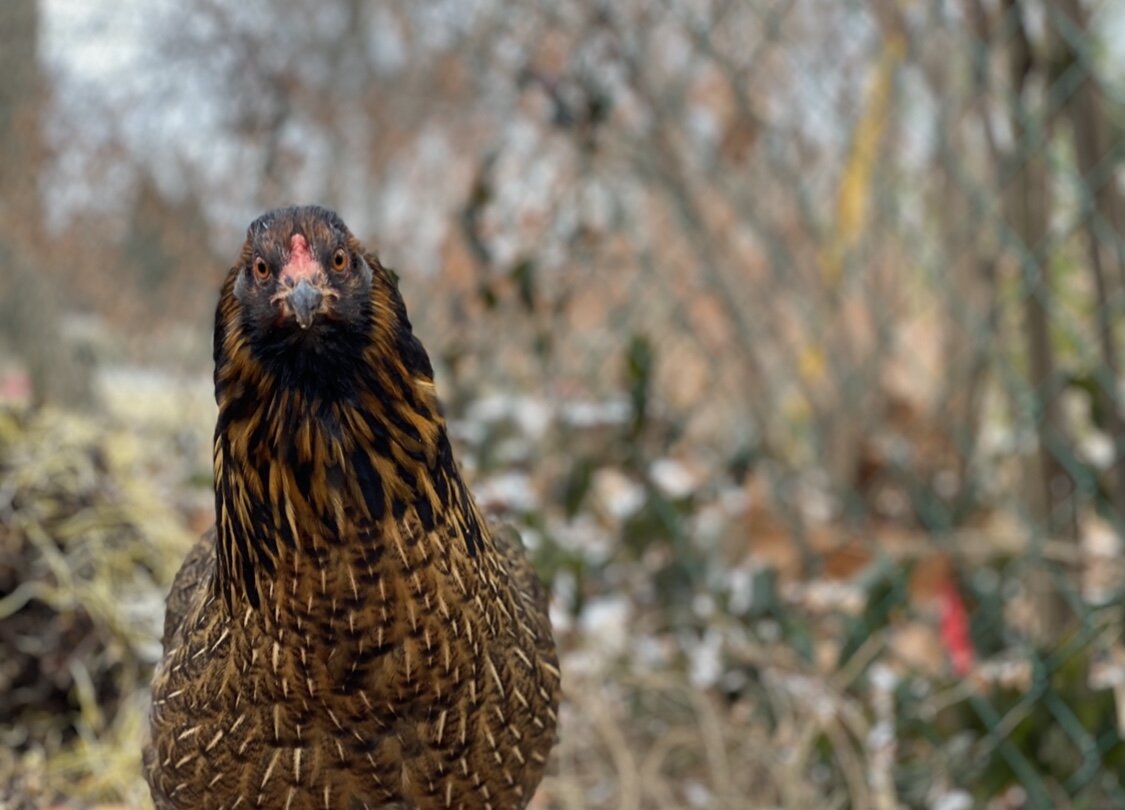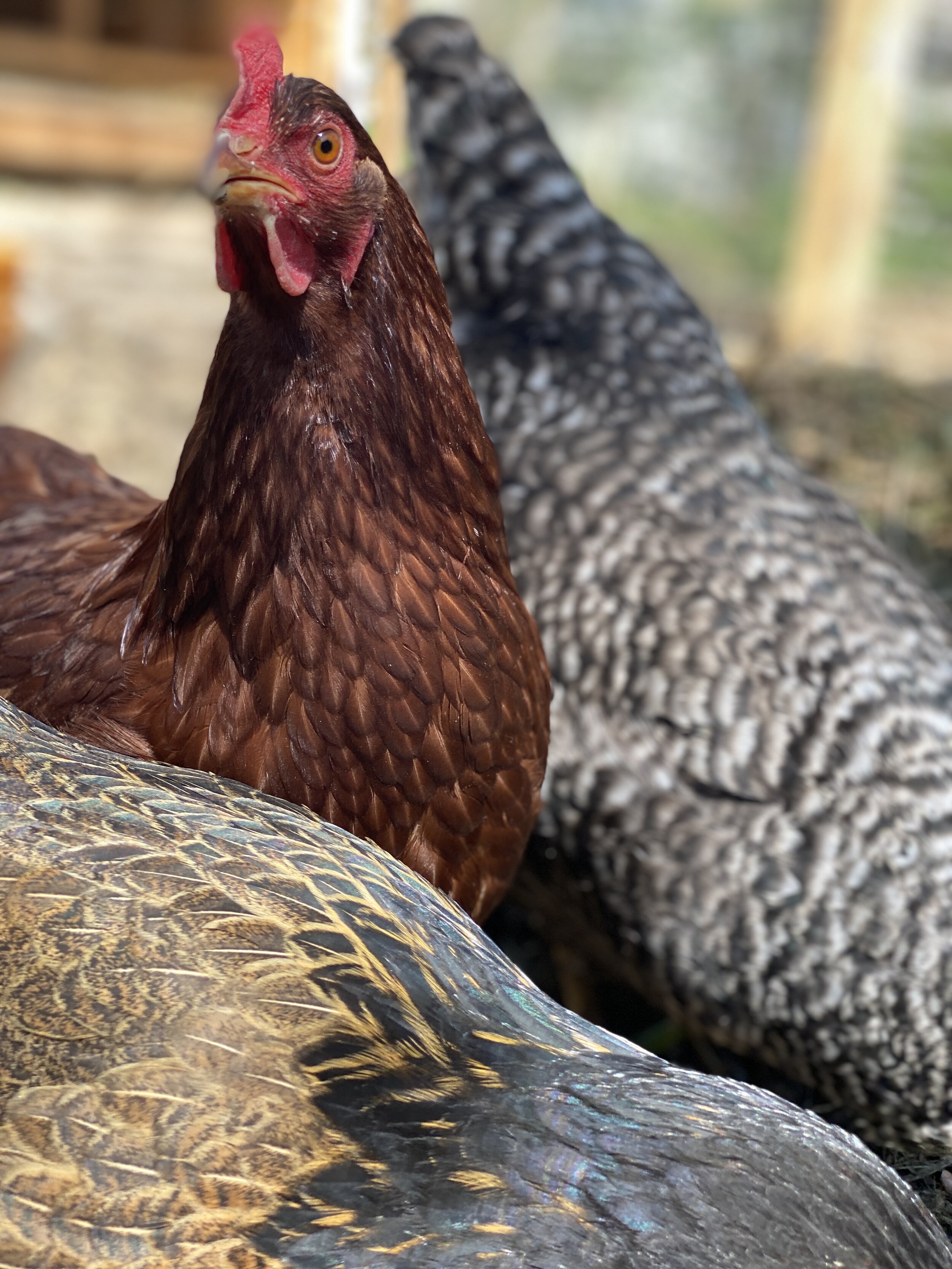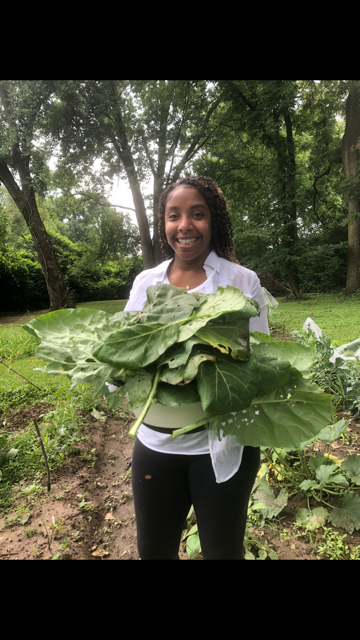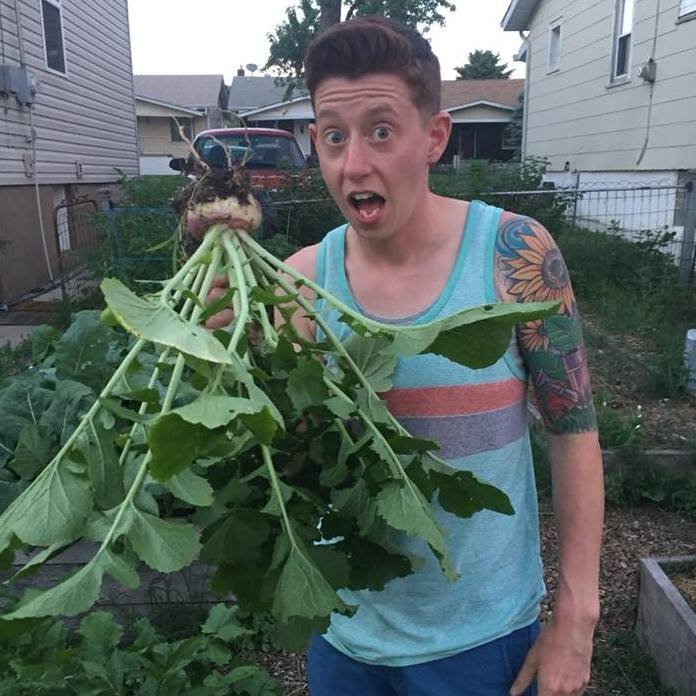How Does Your Garden Grow | Franklin, Webster Groves
Franklin, a St. Louis transplant, grew over 70 varieties of plants last year with the help of his chickens and their compost!
Tell us about your garden!
I just moved here from Los Angeles. With the help of my chicken flock and their compost-making, I began growing microgreens late last year. Sunflower, Broccoli, Kale, Arugula, Cabbage, Kohlrabi. I love growing my micro greens. For spring and summer, I have close to 70 different vegetables just waiting to hit the garden.
We'd love to know more about your garden. How much space do you have? What are some of the challenges you've faced?
I have .10 acre in my back yard. Winter of 2020 was my chickens first winter, but they crushed it. But keeping compost heated through those few weeks in February were tricky. They eat only soaked whole grain and food waste, so keeping that thawed was a bit frustrating. I also have a resident owl and hawk that I like to have strict conversations with. Haha.
Share your knowledge! Do you have any tips and tricks? What are the benefits of gardening for you?
As a compost & chicken farmer, my focus is always on soil health. And the most efficient way to maintain the optimal soil health is to keep it in the traditional farming realm. No sprays, no amendments, no pelletized food, heavy bio-diversity, heavy density; creating an environment that resembles our world before shopping malls and commercial mono-crop farming.
Most importantly, why do YOU garden?
Sustainability is key. Having pure autonomy about what goes our bodies is the only way to go. Once you realize how easy it is to grow your own food and/or watch others discover it, it's whole new level. Like magically traveling to another time in history and watching that first, discarded wheat seed grow into grass, then transform into bread. A forgotten herb that heals wounds. The buried, rotten corn ear that produces food in the hot summer months.
How does YOUR garden grow? Share your photos with us HERE!
How Does Your Garden Grow | Jessica, Bevo Mill
Explore Jessica’s ever-growing garden in Bevo Mill and hear her helpful tips for beginning gardeners!
Tell us about your gardening experience!
After moving to St. Louis from Chicago in 2014, my now husband and I were inspired to start a small backyard garden over the following summer. The climate here is significantly different, despite the short distance! Around this time, we were cooking at home a lot more and we always wanted to join a CSA. Luckily living in Shaw put us close to the Tower Grove Farmer’s Market where we picked up weekly vegetables. After cooking and enjoying fresh produce, I knew I wanted to do that for myself! In Shaw, we did container gardens in five gallon buckets and a front yard three sister garden (corn, beans, and squash). We moved to Bevo Mill in 2018 where we were able to expand our garden! In spring, we grow crops like kale, chard, lettuce, baby cabbages, peas, and broccoli raab. In summer we grow usual favorites like tomatoes, okra, tomatillos, melons, cucumbers, beans, peppers, and eggplant.
We’d love to know about the growth of your garden and any challenges you’ve come across.
Over time, we have added something new each year to our less than 1000 square foot yard. First, we added a space perennial herbs and native flowers. The next year, we added 6 garden beds and berry bushes. The following year, we put in 6 more beds and a peach tree. This year, we amended the soil, added a repurposed claw foot tub planter and a in ground bed for cherry tomatoes. We also finally fulfilled a dream of mine by adding cattle panel trellises for vertical growth. A huge challenge as a gardener is being patient! I’ve had to learn it takes times and seasons for things to come together. Not everything needs to be perfect and there are always new things to learn along the way.
Share your knowledge! Do you have any tips and tricks?
Join and CSA or visit farmer’s markets to learn about what grows well in your area and discover your likes and dislikes of vegetables and fruit. Notice what varieties are popular in your area.
YouTube, Instagram, and Facebook are your friends! Between following professionals chatting with neighbors on gardening groups, there is so much knowledge to tap into!
Make due with what you have. Use recycled containers and just try! Gardening can get expensive but there are many ways to save. My favorite hacks are getting compost and mulch from Carondelet Park and trading seeds by mail.
We gained confidence to map out our garden through the work of local business, Custom Foodscaping. Give them a call for a consultation or full garden build.
Celebrate failures as it means you learned something new!
Why do YOU garden?
I love gardening because it allows me to be creative, get outdoors, and grow my own food! As a teacher, I have a lot of free time in the summer. Having a backyard garden brings me joy and something to look forward to each day. There is always something new and beautiful out there!
You can follow Jessica on Instagram at @stl_stead!
How does YOUR garden grow? Submit your photos and tell us more at urbanharveststl.org/share-your-garden
How Does Your Garden Grow | Arion, St. Ann
Learn about Arion’s one-acre garden in St. Ann!
Tell us about your gardening experience and your plans for 2021!
I've been growing in pots for the last 3 years but in 2020 I decided to take it to the next level and do some digging. So far my favorite thing to grow has been collard greens. This year will be even better. I will get a jump start on the season by starting seeds indoors. I've also created a blueprint to incorporate companion planting.
What are your biggest challenges?
I am on an acre of land but one of my biggest challenges are the trees, so I have to be mindful and plant things that don't need a ton of light and utilize a greenhouse and the few sunny spots to the maximum.
Do you have any useful tips or tricks?
Don't throw out those fall leaves! Dump them in the garden beds instead. Using leaves from the fall is a great way to prepare your soil for the next season.
Why do you garden?
Gardening is therapeutic and is also an excellent workout. Seeing your seeds grow into an actual harvest has changed the way I view everything.
How does YOUR garden grow? Submit your photos and tell us more at urbanharveststl.org/share-your-garden
How Does Your Garden Grow | Sam, St. John
Learn about Sam’s gardening journey, her creative approaches to challenges, some helpful trips and tricks (especially for people with kids), and more!
Tell us about your gardening experience!
I started my gardening experience in 2014 when I had the amazing opportunity to teach a 3-5-year-old gardening class at a children’s museum. I will admit I learned a lot by failure and took some time to get used to gardening in the desert climate of Los Angeles. Once my family and I moved back to St Louis it got a lot easier due solely to knowing that rain was a thing here. Ever since then we have slowly grown our garden(s) at our house and I continued to learn more while working at the Missouri Botanical Garden.
My favorite thing to grow is flowers, especially zinnias, marigolds and sunflowers. As much as I love growing food, flowers are what bring all the beneficial insects that both my kids and I love to watch. We had one Mexican Sunflower (Tithonia rotundifolia) and would see up to 15 butterflies on that one plant at the same time. Adding flowers through our edible garden also breaks up all the green foliage bring much-appreciated beauty to space. That being said I love growing cherry tomatoes – one of my favorites snacks to eat while working in the garden.
The biggest change in our garden is the addition of a giving garden in our front yard. We have a decently sloped area of our front yard next to the sidewalk. Rather than mowing the evil hill, we are going to be planting it up with cut flowers and edible plants so anyone can harvest what they need. May that be a handful of herbs, a few tomatoes or a bouquet of flowers to bring life to their house.
Back in 2020, we took down 2 trees in the backyard opening up a lot more light. We will be adding a food forest area in the backyard including many fruit trees, raspberries and of course native flowers.
Tell us a little bit about your growing space! What are some challenges you’ve encountered?
My family is my first priority and sometimes my biggest challenge in the garden.
First, my husband is extremely allergic to the outside world. If he comes outside while someone else is mowing their lawn he tends to break out in hives. Or if I mow our lawn then our dog’s tack in clipping onto the sofa he goes into anaphylactic shock. I personally want to fill our whole yard with native plants and edibles, I also know my kids in a space to play. Finding this balance between gardens and play areas is the second challenge I face every year when I am planning the space out. Luckily our next-door neighbors have a child the same age as my oldest and the three kids tend to fence hop all day long. This has to lead to their yard as the running yard and ours the adventure yard. All of the plants we grow are great for playing hid and seek, looking for bugs and we even plant some of our neighbor’s favorite foods for him to snack on while playing in our yard too. This has allowed me to slowly covered half our backyard with growing spaces and a lot less grass to aggravate my husband's allergies.
Our home sits on around the 10th of an acre (which is really just fancy saying 5,000sqft) and our garden is around 1,200sqft..which is around the same amount of space as our house in comparison. This includes our new giving garden in the front yard, our market garden style veggie patch and a new food forest in the back yard. And lastly B.A.R.B., our Big A** Raised Bed. BARB was the first garden we built with motorcycle pallets we got off of Craigslist 4 years ago. BARB is 21’x3’x4’ which has been great to grow herbs and veggies that I only want to grow one of. This year we have added old windows that I have collected to make a mini greenhouse to start all of my plants this spring.
What are some tips and tricks for other gardeners? What are the benefits of gardening for you?
Gardening should be enjoyable.
One of the main reasons we built BARB was because my mom wanted to help in the garden but couldn’t do the bending for traditional in-ground gardening anymore. In the summer I don’t even start working on my garden until after dinner normally because of the heat. There are times that my beds get super weedy and I let it happen because I know the world will not end if I wait until I feel like I am up for the task. Yes, I want to have a beautiful garden but don’t make it so complicated that it is no longer enjoyable.
Also, listen to your garden. I have made my life a lot harder before because I was trying to force plants to grow in areas they were not suited to. Look where the sun hits, where water pools, where the high traffic areas are in your yard. Hint: don’t plant something in the direct path from the swing set to the house when you are potty training...plants will get squished in a bathroom emergency! Listening to your garden goes further than that though – if you notice low production, you might be missing pollinators like the native bumblebee...plant some flowers among your veggies. Squirrels only go after your tomatoes...most likely they are thirsty so add a water score. Missing lightning bugs thought the summer added bushes for them to hide in thought the day.
Even though I have worked with plants for the past 4 years as my job I truly find gardening fun. I love the planning of what I want to grow, the act of getting my hands in the soil is satisfying. Solving the mystery of why a plant is struggling and finally, harvesting makes me want to give myself a pat on the back. My biggest benefit though is seeing how much my kids love the garden. Whether I want their help or not they are in the garden with me.
Why do YOU garden? What does gardening mean for you?
It is very important to me that my kids have a strong connection with nature. The easiest way to do that is to make our yard an enjoyable place they want to be in.
They go through the seed catalogues in the winter and they help me pick what we should grow. This has led us to have a small Disney section with Rapunzel Tomatoes, Cinderella pumpkins and Hercules Carrots. My son has requested we grow his weight in raspberries and cucumbers. Their love of the garden is what keeps me going some days and allows me to grow in so many gardens.
Sam is the Volunteer Coordinator and Assistant Farmer at Urban Harvest STL! Read more about her here.
How does YOUR garden grow? Submit your photos and tell us more at urbanharveststl.org/share-your-garden
How Does Your Garden Grow | Claire, South City
Read about how Claire’s gardening practice flourished during the pandemic!
Tell us about your gardening experience!
I started gardening 4 years ago because I knew that nothing beats the taste of a home grown tomato. I started in food-grade buckets but upgraded to my first garden bed the following year. As someone that enjoys cooking for people, I realized that sharing my produce with others brought me the same kind of fulfillment. Last spring, the uncertainty of COVID-19 gave me an unexpected surplus of time spent at home. That's when I enlisted my boyfriend to help build three raised beds in addition to amending the soil in three more ground-level ones. I bought organic starters from Biver Farms, at Local Harvest Grocery, and I spent hours researching the best way to lay out my new garden.
Describe your garden! What are some challenges in your space?
I have about 1600 square feet in my backyard, and much of it is still dedicated to running space for our dogs. Growing melons and squash for the first time was pretty tricky. I had no idea how their vines would sprawl, so trying to wrangle them into a good space was a challenge. I've also struggled with aphids and trying to repel the pests using organic growing methods. To combat that, I'll be incorporating both trap crops and flowers that repel them this year. I also try to use companion planting and crop rotation to maximize space and soil quality.
Do you have any tips and tricks? What are the benefits of gardening for you?
Trellis gardening is magical, especially for those with limited space! I grew cucumbers on a trellis last year, and it kept them powdery mildew-free while creating a beautiful wall of green on my fence. I highly recommend using trellis netting for any crops that like to climb. This one sounds cheesy, but spend time with your plants! When you visit with each plant in your garden, ideally multiple times a day, you can learn what they like and dislike. Plants are expressive, and you can use that to your advantage. The benefits are endless. Last year, I gave produce to friends in exchange for donations to local, food justice-focused non-profits. As an amateur chef, there is nothing cooler than going out back to harvest food for your meal.
Most importantly, why do YOU garden?
Giving back to the community while fostering connections between friends and their food is joyous. I love walking people through my garden and showing them exactly where their food comes from. It's a great chance to share cooking tips or plug my passion for local, pasture-raised meat as well. Time spent alone in my garden is equally fulfilling. I enjoy taking the time to sit with myself and reflect. Our dogs appreciate it too!
How does YOUR garden grow? Submit your photos and tell us more at urbanharveststl.org/share-your-garden
Announcing our new Interim Executive Director, Jamie Wallace
A statement from Urban Harvest STL’s Board of Directors
As an organization, we’ve never been one to shy away from a challenge – from building a rooftop growing space when our ground-level farms were uprooted, to expanding from one farm site to a network across the city, to growing and donating more food than ever before despite a global pandemic.
Clare Higgins Siegel, former Executive Director
Since the fall of 2018, we have been led in these efforts by Clare Higgins Siegel, board member-turned-Development Director-turned Executive Director. Clare’s long-term commitment to the organization, her welcoming presence, and her generous leadership during such a formative period have helped Urban Harvest STL define its role in St. Louis’s food justice movement and catalyze the work to which we aspire in our mission.
We celebrate Clare’s years of dedication to Urban Harvest STL as we announce that she will be stepping away from her role as Executive Director to focus on her family after the birth of her twins.
Jamie Wallace, Interim Executive Director
We are also thrilled to share that Jamie Wallace, formerly Director of Operations, will be continuing to guide us in our work as the new Interim Executive Director.
Jamie has been involved with the organization since 2015, first as a volunteer, then as a board member before joining the leadership team. She has worked closely with Clare since 2018 to grow the organization and foster meaningful partnerships, programs, and antiracism efforts.
We are confident that appointing Jamie in this Interim role will allow Urban Harvest STL to seamlessly continue the work on our farms and in the community while we take the time to move forward intentionally and deliberately in order to make the best possible decisions for our organization and our community.
We are excited about this new chapter in our organization and will continue to keep you updated!
Get Started: Indoor Gardening Activities for Kids
Learn how to re-grow food from scraps!
Simple Indoor Gardening Activities for Kids
It’s almost spring, which is a great time to explore plant and garden activities with children. There are many fun options for families even if you do not have an established garden or an outdoor growing space. Last season, we shared a great indoor seed germination project. This post introduces two family-friendly activities that require very few materials or growing experience, use left-over “kitchen scraps” and easy to find vegetables, and provide a hands-on growing experience for children of all ages.
Regrowing Food from Vegetable Scraps
This project can be done with a variety of common vegetable scraps, such as green onions, romaine lettuce, or celery (bottom 2-3”). You may also use the “tops” (top 1-1.5”) of root vegetables like carrots and beets with the same technique.
MATERIALS:
Vegetable scraps of choice
Water
Shallow glass or dish (clear if possible)
Sunny window
(Optional) potting soil and container
STEPS:
Keep the bottom 2-3” of celery, lettuce or green onion. If using root vegetables, keep the top 1-1.5” of the carrot, beet, radish, etc.
Place the vegetable ends in a shallow dish or glass and cover with a small amount of water, making sure to only cover about ½” of the base.
Place the dish on a sunny windowsill.
Replace with fresh water daily or when you notice the water in the dish is getting murky or brown. This is a great task for kids.
Watch the plant grow! New growth will emerge from the center of the scraps. Older kids may enjoy measuring and tracking the growth of the new plant and watching for the emergence of roots in the water. The plants are usually fast growing and fun to watch!
After ~2 weeks, you should see new roots growing in the water. At this point you can either cut off and eat the new leafy growth, or you can plant the base of the vegetable in a container with potting soil and allow it to grow even larger. Root vegetables like carrots will need to be transplanted into soil to fully regenerate.
If you re-pot the plant, continue to water it near the soil, keeping it moist but not soggy. When the plant is your desired size, harvest and enjoy!
Sweet Potato Houseplant
Sweet potatoes are vining plants with heart-shaped leaves that make a beautiful and easy to set-up houseplant. This project is an excellent demonstration of plant growth for children, and has the option of extending to an outdoor project, if desired.
MATERIALS:
Whole Sweet potato (*may have better luck with organic varieties)
Jam or Mason jar
Water
Toothpicks
Sunny window
(Optional) potting soil and container
STEPS:
Stick 3 - 4 toothpicks into the midpoint of the raw sweet potato, about half way down the length. These will rest on the lip of the jar to suspend the potato above the water.
Fill the jar with water and place the potato into the opening of the jar with the “pointed” end facing down and submerged into the top inch of water.
Place the potato jar on a warm and sunny windowsill, and monitor the water level to keep the bottom inch of the potato submerged.
After 2-4 weeks, you should be able to see new root and leafy growth. This is a great chance to talk to children about the parts of the plant and the role of roots in “drinking” water to keep the plant alive. Ask children to observe changes in the plant; older kids might enjoy recording and measuring the new growth.
(Optional) When the roots grow long enough to reach the base of the jar, you may re-pot the potato in a container with potting soil and compost blend. The pot should be big enough to contain the roots without cutting or folding them. This will allow the plant to continue to grow, and you can continue to transplant into larger pots as a houseplant when the roots outgrow the container.
(Optional) You may also break off the new shoots from the top of the potato (make sure you get at least 4-6”) or plant them outdoors as “slips” if you want to obtain a harvest later. Children LOVE digging for sweet potatoes! Sweet potato vines are sprawling and will need either space or a trellis to grow on.
How Does Your Garden Grow | Ro, Bevo
Ro’s backyard is home to 33 raised beds and a greenhouse - a space also known as Feed the People Garden Project!
Tell us about your gardening experience!
I began my journey into gardening about 10 years ago. It all began when I became a first-time homeowner. I was so excited to add my own personal touches to the yard. I knew that I wanted to plant hydrangeas, but didn't know a thing about gardening. Once I get started with planting my front yard, I absolutely got the "garden bug" and haven't stopped since. Gardening has become my biggest passion, and the absolute best thing that I have done for myself. It helps to support my mental and physical health, relieves stress, keeps me grounded, and gives me something to look forward to during the hard winter months.
My absolute favorite things to grow are tomatoes! There are endless varieties to choose from, they are extremely prolific and delicious, and the plants smell amazing. I love going down a row of tomatoes, pruning them, being in the moment, and enjoying their abundance. I also love throwing the ones that get nibbled on, split, or messed up in some way to my chickens. They LOVE fresh tomatoes!
My garden plans for 2021 are to really maximize the amount of produce we are able to grow and donate. I have removed some of the plants that take up a lot of space and a long time to produce, such as broccoli, and plan to take full advantage of all 3 seasons. I am trying a few new items to feed our soil life and add nutrients, such as alfalfa pellets, and will be adding a lot more beneficial herbs and flowers.
Share a little more about your garden itself.
Feed the People Garden Project has 33 raised beds. Some are made from cedar pickets, some from cinder blocks (my favorite), some have log borders and were created using the lasagna layering method, and some are made from untreated 2 x 12 boards. We have tons of cattle panel trellises to support tomatoes, cucumbers, beans, and other vining crops. We also have a food forest, where the chickens spend their daytime hours scratching, fertilizing, and doing insect management. We also have a small 6ft x 8ft greenhouse that has really increased our capacity to start plants from seed.
Our biggest challenge has definitely been squash bugs. We will not be growing squash for the next 3 years in order to try to remove the issue. Other challenges include our *super helpful* garden pups that like to go through and undo much of the work that gets done, keeping up with a garden of this size that is run entirely by volunteers, and mosquitoes during the hotter months.
Do you have any gardening tips and tricks?
Plan ahead! Use the winter months to learn as much as you can and really think through what your are planting, what materials you still need, and how you what you want your season to look like. Focus on your soil prep and putting up any trellises and such before the growing season kicks off, so that when it is time to plant you can focus on that. I try to always make my soil my top priority, because having good soil is critical to having good crops. Compost is your best friend! Don't skip it! Try to source used materials or tools. Many people have sheds and basements full of goodies that they aren't using. Often, you can get much of what you need for free or low cost, rather than purchasing new.
Why do you garden?
Gardening brings me to life! It is incredibly centering, healing, and motivating. It provides endless opportunities to continue learning, try new methods, fail and try again. For me, it is also a way to build community and to give back to community. I love being able to bring folks together (during non-covid times) for big gardening days and seed swaps! We have many folks in our community that are food insecure, and being able to grow and donate fresh healthy produce is a way to help support that need.
Follow along with Ro’s gardening adventures at the Feed the People Facebook page! Ro is also a staff member at Urban Harvest STL and manages our farm at Rung for Women.
How does YOUR garden grow? Submit your photos and tell us more at urbanharveststl.org/share-your-garden
Getting Stared: Seeding Spring Crops Indoors
Dig a little deeper into why, when, and how to start your seeds indoors before you plant them outside!
Why Start Seeds Indoors?
It is a great idea to plant seeds indoors for crops that tolerate transplanting into your garden as seedlings. Plants started indoors have better germination rates due to a stable environment and protection from pests, and vigorous seedlings can flower and be ready to harvest sooner. Plus, you’ll soon have beautiful baby plants to brighten up the last dreary days of winter!
What Seeds Can I Plant in Winter?
Not all plants like to be transplanted as seedlings, but many popular crops get a good head start indoors. Seed packages will indicate if the seed can be started indoors or be sown directly outside. Many early crops, including broccoli, cauliflower, kale, and lettuces, can all be started in February! Our farmers start the following spring crops in our greenhouse: kale, collards, mustard, and Swiss chard.
Other crops that will transplant into your garden early and tolerate light frosts include: all brassicas (Broccoli, Brussels sprouts, Cauliflower, and Cabbage), and leafy greens such as Collards, Mustards, and all Lettuce varieties.
The right time to start seeds indoors depends on two main factors: 1) When they can be planted outside, and 2) How long they need to grow to the appropriate size. To figure this out, you need to know your region’s average last frost date. In Missouri, we are in zone 6B and this date is April 15th. This is the date that divides when you can transplant early crops (that tolerate light frost) from those that must be transplanted weeks after the last frost in warmer soil.
Many warm season vegetables and herbs can also be started early (February or March), and kept for longer indoors. By the end of February, our farmers will start tomatoes, peppers, eggplant, thyme, sage, and lavender seeds in our greenhouse. These seedlings need more time to be ready for transplant, so it helps to start them early.
Find your Planting Calendar
This can seem like a lot of information to manage! Getting some help from a good planting calendar helps you determine when to start your crops. Many agricultural extension services publish calendars for their region. Here in Missouri, Missouri University Extension maintains a guide on when to start seeds indoors and a planting calendar that details when transplants can be moved outdoors and seeds be sown directly outside.
DIY Seed Trays
Popular seed-starting containers that you can purchase at a nursery or home and garden store include: plastic, wooden, or fiber trays, small plastic or ceramic pots, biodegradable peat pots, and peat pellets. However, if you’re looking for upcycling options to save money and reuse materials, you have many options! Here are some fun DIY seed tray ideas: Eggshells and egg cartons, Takeout containers, milk cartons, toilet paper rolls, and newspaper pots.
Tips for Strong Seedlings
Germination medium
You may purchase or make your own germination mix, which must be fine-textured, loose and light weight, and drain quickly. It is best not to use regular planting soil or fertilizer at this early stage.
The primary components of these mixes are: Perlite, Peat, and Vermiculite
Enough light
Seeds do not need light to germinate, but once they’ve sprouted they will definitely need plenty! Seeds often do very well under “grow lights,” but if this is not something you can do, make sure to place them in a south-facing window to maximize how much sunlight they get each day.
Air circulation
Initially, many growers cover their seed trays with a clear plastic dome. This creates a mini-greenhouse effect, trapping humidity and warmth to promote germination. Once your seeds have sprouted, however, it’s a good idea to remove the dome regularly to get fresh air to the seedlings.
Air flow and a breeze on your growing seedlings will help strengthen their stems. Many gardeners set up fans indoors to circulate air, but you can also replicate this effect by regularly running your hands gently over the seedlings to simulate air movement.
Watering
Seeds and seedlings do best when kept evenly moist. Too much water will promote mould growth in your germination mix or even drown your roots. Check daily to make sure that the growing media is damp rather than dry or soaking, and lightly water when needed.
For more details, check out MU Extension’s guide to starting plants indoors from seed.
Scrap Gardening for Beginners
Scrap gardening is great for beginners who are wanting to experiment with their first garden and for those who just do not have room for a large garden in their yard. It is also a great way to save money on fresh food!
By Savannah Kohler, Leadership in Urban Agriculture Internship, 2020
An estimated 1/3 of all food that was made for consumption, ends up as waste instead. (1) Along with composting, scrap gardening is one of many strategies used world-wide to help with the reduction of food waste. While eating a higher quality diet is related to less cropland waste, it does have a negative association with food waste. (2) By taking the time to turn some of our kitchen scraps into a small scrap garden, we are doing our part in helping to provide a sustainable food system.
Scrap gardening is great for beginners who are wanting to experiment with their first garden and for those who just do not have room for a large garden in their yard. It is also a great way to save money on fresh food!
How is this done?
While each plant may vary in the amount of water used, the length cut of the scraps, and the amount of time it takes to regrow, it is all still remarkably easy and very much achievable! To begin, you will need for your plants to grow roots. See below for instructions.
What plants can I regrow?
You can regrow most of your veggies and fruits, but not all. Here are some examples of popular options that you can regrow and how to do it.
GREEN ONIONS: Cut off the top of the plant and keep the end that grows roots. Plant it in potting soil and place it in a well-lit room. Soon, the green onions will begin to grow back, and you can snip them off the plant and use them as needed.
CELERY: Cut the stalk, leaving about two inches at the bottom. Place the two-inch-long end in a bowl of very shallow water. When leaves begin to grow on top, you can move into potting soil and watch it grow.
ROMAINE LETTUCE: Cut the lettuce, leaving about two inches at the bottom. Place the two-inch-long end in a shallow bowl of water. As leaves grow, you may eat them.
POTATOES: Wait until your potato is starting to sprout. When it does, cut the potato in slices around the sprouts. Plant in deep soil with the eye facing up. Cover the potato entirely with soil.
HERBS: Pick most leaves from the stem, while leaving the only top few remaining. Place the stems in a glass of water. Replace the water every few days. Plant stems in soil once they have grown their roots.
Helpful Links:
https://www.diyncrafts.com/4732/repurpose/25-foods-can-re-grow-kitchen-scraps
References
Anastasia M, Alexandru J, Liliana S(C. Studies on the use of vegetable scraps. https://ibn.idsi.md/ro/vizualizare_articol/72422. Published February 20, 2019. Accessed July 27, 2020.
Conrad Z, Niles MT, Neher DA, Roy ED, Tichenor NE, Jahns L. Relationship between food waste, diet quality, and environmental sustainability. Plos One. 2018;13(4). doi:10.1371/journal.pone.0195405
